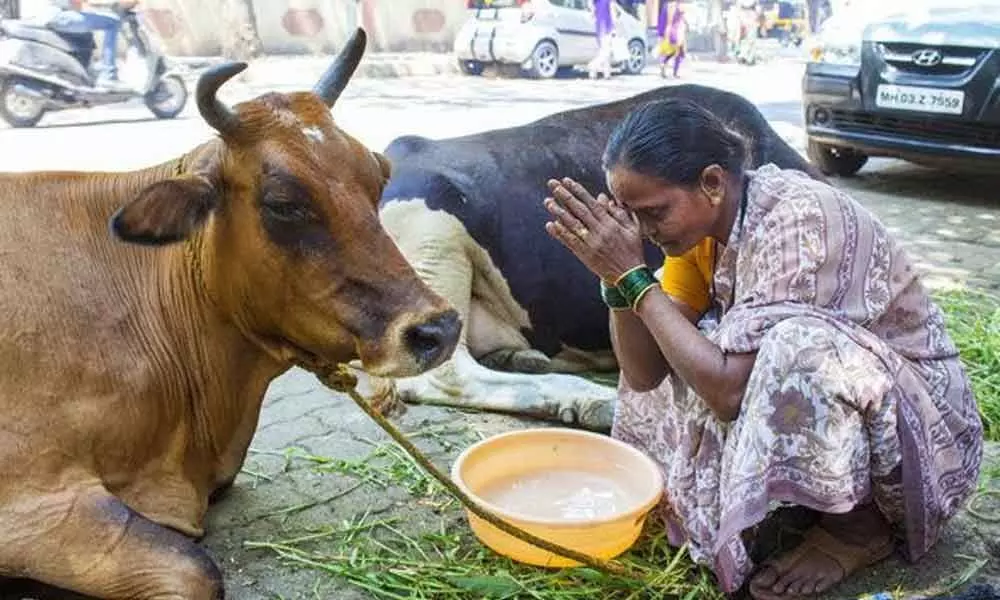Extricate the cow from the zoo

Farmers used to rear cattle with pleasure till a few decades ago. Today they are abandoning them on road. These abandoned cattle are destroying crops of farmers.
Farmers used to rear cattle with pleasure till a few decades ago. Today they are abandoning them on road. These abandoned cattle are destroying crops of farmers. The cattle have become a curse instead of a boon to the farmer.
The government is collecting these stray cattle and trying to make adequate numbers of shelters to keep them in just as a variety of animals are kept in the zoo.
The first reason behind this change is the disappearance of common grazing lands. The cows like to graze. Previously our villages had common grazing lands where the cows would graze and produce milk, dung and progeny with very little requirement of additional feed.
The common grazing lands have been captured by the powerful or used for other purposes like building of schools by the government. The cow has been deprived of her traditional grazing lands and is no longer able to produce milk, dung and progeny virtually for free.
The farmer has to now stall feed the cow which has made it difficult for him to rear cows.
The second reason for the decline of the cow is that ploughing is now done by tractors, irrigation by bore-wells and threshing by threshers. The requirement of bullocks for these operations has disappeared.
Consequently, the male progeny of the cow has now become a burden upon the farmer. The farmer now keeps the male progeny only as long as the cow gives milk. He then abandons the progeny.
The third reason is that the government has prohibited killing of cows including the male progeny. Previously the male progeny that was not required for agricultural operations was sold to the butchers and that provided some income.
The farmer has been deprived of this income because the male progeny can no longer be sold to the butchers. The cow has become a burden on the farmer for these three reasons and he now prefers to rear a buffalo.
The buffalo is a sedentary animal and is not impacted by the disappearance of common grazing lands. The male progeny of the buffalo is not used for agricultural operations and also can be sold to the butcher.
The situation of the cow has become more adverse because the quality of the milk of the buffalo is found to be superior to that of the cow according to present standards. There are two major components in milk — fat and solid non fats (SNF).
The SNF contains beneficial vitamins and minerals. According to the website of Vrindavan Organic Dairy Products, the buffalo milk contains 8.0 percent fat while cow milk contains only 3.9 percent, buffalo milk contains 10.9 percent SNF while cow milk contains only 8.3 percent, buffalo milk contains 0.18 percent calcium while cow milk contains only 0.12 percent, buffalo milk contains 0.02 percent magnesium, cow milk contains only 0.01 percent, buffalo milk contains 0.14 percent phosphorous while cow milk contains only 0.10 percent.
Among these elements, the buffalo milk is less beneficial only in potassium since buffalo milk contains 0.11 percent potassium while cow milk contains 0.15 percent. Buffalo milk is also beneficial because it has less cholesterol which is the source of heart diseases. The buffalo milk contains 8 units of cholesterol while cow's milk contains 14 units. For all these reasons the consumer prefers buffalo's milk.
The government has proposed to improve the breed of the cows in order to save her. The semen of stronger breeds will be used to improve the weaker breeds. The difficulty is that cows of stronger breeds are themselves under pressure.
This strategy could perhaps have been successful if the stronger breeds had been expanding in the face of competition from the buffalo. But they are not. In the present scenario, it is like one drowning person trying to save another drowning person. The second proposal is to make marketable products from cow dung and urine.
About 20 years ago, I had visited an exhibition in Kanpur where roofing sheets made of dung were displayed. A friend has made electricity generator that can be run with the bullock's draught power. However, none of these products has been commercially successful.
The government must consider an alternate strategy. First, it must have the common gazing lands released from the clutches of the powerful. That would make available grazing land for the cows and the cost of rearing a cow would become less.
Second, the government should commission a thorough study on the difference in the quality of milk of the cow and the buffalo. As mentioned above, the buffalo's milk turns out to be superior on most parameters according to the present standards. However, it is said in our tradition that drinking buffalo's milk makes the mind like that of the buffalo.
The same problem stands before us in terms of the spiritual benefits of the cow. I have not seen a study which compares the milk of buffalo and cow on psychological parameters. It is possible to feed two sets of children with buffalo and cow milk respectively and then measure their psychic profile, say, after a month.
Psychologists also have techniques of mapping the emotional profile of a person. The same problem inflicts the anecdotal evidence regarding the health effects of cow urine. My father-in-law was suffering from cancer.
He used to take capsules of cow urine. He felt better. I use cow urine as an insecticide in my garden regularly. However, I am not aware of a credible study in this respect. Such studies would create an attraction among the consumers towards cow's milk and curative powers of cow urine.
Drug manufacturers routinely make such clinical trials. The government can commission such clinical trials which could serve as a proxy for emotional and spiritual benefits.
In fact, this study should be got done separately for native and exotic breeds of cows. Anecdotal belief is that physical and spiritual benefits of native cows are much greater than exotic breeds.
Third, with a sad heart, we must think whether to grant permission to slaughter the male progeny of the cow. The farmer is today abandoning the male progeny and they are dying in one way or the other anyways.
The difference is that giving permission to slaughter will provide income to the farmer and possibly make it profitable for him to rear a cow instead of a buffalo.
In our penchant to save the male progeny, we are actually destroying both the male and the female. The Kamdhenu Ayog should focus on these core problems that afflict the cow.
Author was formerly Professor of Economics at IIM Bengaluru
















